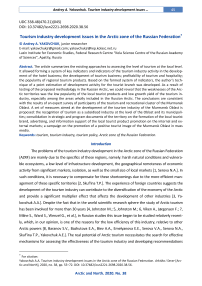Tourism industry development issues in the Arctic zone of the Russian Federation
Автор: Yakovchuk Andrey A.
Журнал: Arctic and North @arctic-and-north
Рубрика: Social and economic development
Статья в выпуске: 38, 2020 года.
Бесплатный доступ
The article summarizes the existing approaches to assessing the level of tourism at the local level. It allowed forming a system of key indicators and indicators of the tourism industry activity in the development of the hotel business; the development of tourism business; profitability of tourism and hospitality; the popularity of regional tourism products. Based on the formed system of indicators, the author's technique of a point estimation of development activity for the tourist branch was developed. As a result of testing of the proposed methodology in the Russian Arctic, we could reveal that the weaknesses of the Arctic territories was the low popularity of the local tourist products and low growth yield of the tourism industry, especially among the areas wholly included in the Russian Arctic. The conclusions are consistent with the results of an expert survey of participants of the tourism and recreational cluster of the Murmansk Oblast. A set of measures aimed at the development of the tourism industry of the Murmansk Oblast is proposed: the recognition of tourism as a subsidized industry at the level of the Oblast and its municipalities; consolidation in strategic and program documents of the territory on the formation of the local tourist brand, advertising, and information support of the local tourist product promotion on the internal and external markets; a campaign on the promotion of a positive tourist image of the Murmansk Oblast in mass media.
Tourism, tourism industry, tourism policy, arctic zone of the russian federation
Короткий адрес: https://sciup.org/148318406
IDR: 148318406 | УДК: 338.48(470.21)(045) | DOI: 10.37482/issn2221-2698.2020.38.56
Текст научной статьи Tourism industry development issues in the Arctic zone of the Russian Federation
The problems of the tourism industry development in the Arctic zone of the Russian Federation (AZRF) are mainly due to the specifics of these regions, namely: harsh natural conditions and vulnerable ecosystems, a low level of infrastructure development, the geographical remoteness of economic activity from significant markets, isolation, as well as the small size of local markets [1, Serova N.A.]. In such conditions, it is necessary to compensate for these shortcomings due to the more efficient management of these specific territories [2, Skuf'ina T.P.]. The experience of foreign countries suggests the development of the tourism industry can contribute to the diversification of the economy of the Arctic and provide a significant multiplier effect that affects the development of other industries [3, Ya-kovchuk A.A.]. Despite the fact that in the world scientific research sphere the study of Arctic tourism has been involved for more than 30 years [4, Johnston M.; 5, Johnston M.; 6, Viken A., Jørgensen F.; 7, Milne S., Ward S., Wenzel G., et al.], in Russian studies this issue began to be studied relatively recently, which, in our opinion, is one of the reasons for the low efficiency of this industry, relative to other Arctic powers [8, Baranov S.V., Bazhutova E.A., Biev A.A., Emelyanova E.E., Serova V.A., Serova N.A., Skuf'ina T.P., Yakovchuk A.E.]. The real potential of Arctic tourism necessitates the search for effective mechanisms for assessing the effectiveness of the tourism industry and developing recommendations
for its improvement. To solve this fundamental problem, we have studied the main issues of tourism development and the factors hindering its growth in the Arctic. The practical significance lies in the development of recommendations possible to be used to improve the tourism legislation of the Arctic regions of the Russian Federation.
Methodology for assessing the development activity of the tourism industry
Consideration of existing approaches to evaluate the level of development of the tourism sector [9, Yuvanen E.I.; 10, Murina S.G.; 11, Rubtsova N.V.; 12, Rubtsova N.V.; 13, Meleshenko N.A.; 14, Kumar M., Prashar S., Jana R.K.; 15, Javid E., Katircioglu S.] made it possible to formulate a system of key indicators and indicators of activity in the development of the tourism industry at the regional level (Table 1).
Table 1
Key indicators of tourism industry development activity
|
Indication |
Indicator |
|
Hotel business development |
|
|
Tourism business development |
|
|
Profitability of the tourism and hospitality industry |
|
|
The popularity of regional tourism products |
|
Based on the formed system of indicators, the authors developed a method for scoring the activity of tourism industry development, according to which the growth rate of the all-Russian indicator is assigned — 1.00 points, and points for the studied regions are assigned according to the formula:
_ 7^= 2 √ ∗ *2 ∗… = = √ xt ∗ x2 ∗… xn
B[ — region ranking score “I”;
TRt — the average annual growth rate of the region “I”;
TRF — a yearly average growth of the all-Russian indicator;
n — the number of periods with growth factors;
X — chain growth rate.
Further, the score for a specific indicator was calculated as the arithmetic average of its indicators.
Assessing the development activity of the tourism industry
The assessment of the development activity of the tourism industry based on the formed system of indicators was carried out considering open data from a single interdepartmental information-statistical system (SIISS)1.
The first indicator of the active tourism industry development is the "development of the hotel business." A comprehensive assessment requires the following indicators to be considered: the growth rate of the number of collective accommodation facilities in the region (Fig. 1), the growth rate of the number of places in collective accommodation facilities in the region (Fig. 2), the growth rate of the number of people working in collective accommodation facilities (Fig. 3).
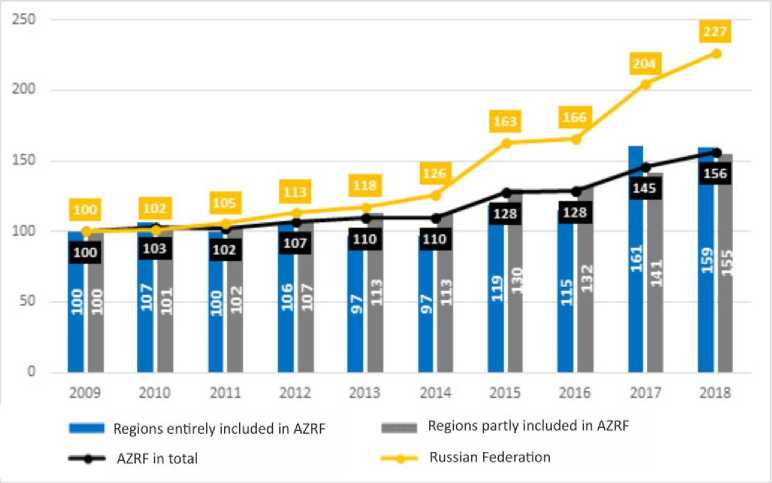
Fig. 1. The growth rate of collective accommodation facilities in the region (% compared to 2009).
This indicator reveals a stable growth both at the all-Russian level and in regions of the Russian Arctic. However, the growth rate of the number of collective accommodation facilities in Russia is much higher than the growth rate in the Arctic regions. In 2017 and 2018, growth rates for this indicator in regions that are entirely part of the Russian Arctic overtook the growth rates of partially arctic regions.
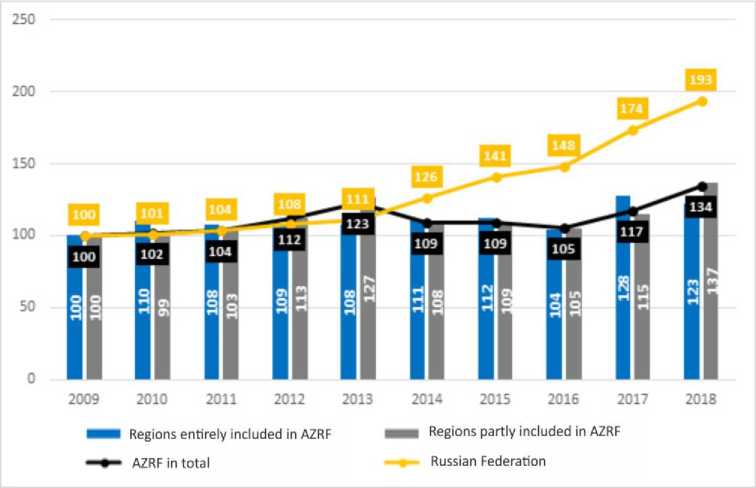
Fig. 2. The growth rate of the number of places in collective accommodation facilities in the region (% compared to 2009).
According to this indicator, stable growth is observed at the national level; however, at the level of the regions of the Russian Arctic, steady growth was kept until 2013, then there was a decline until 2016, and only since 2017, there has been a positive trend. It is worth noting that the growth rate of the number of places in collective accommodation facilities in Russia is much higher than the growth rate in the Arctic regions. In 2017, the growth rates for this indicator in regions that are entirely part of the Russian Arctic were ahead of the growth rates of partly Arctic regions.
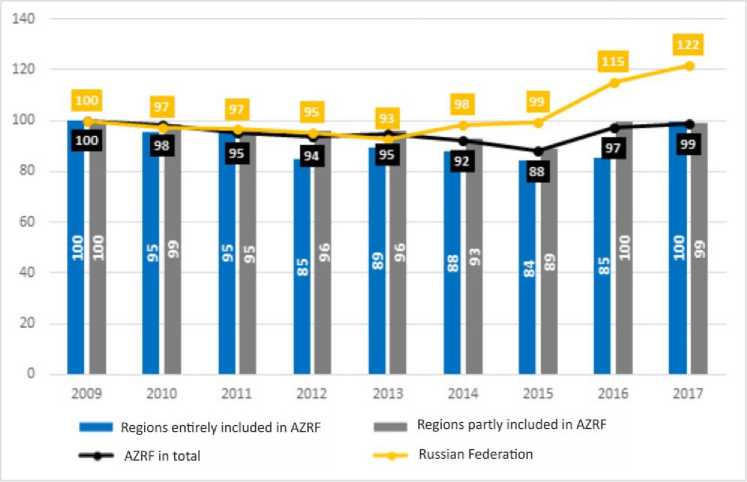
Fig. 3. The growth rate of people working in collective accommodation facilities (% compared to 2009).
According to this indicator, a stable decline is observed until 2013. At the all-Russian level, growth has been observed only since 2014, and at the level of the Russian Arctic regions, since 2016. It should be noted that the growth rate for this indicator in Russia is significantly higher than the growth rate in the Arctic regions. In 2017, the growth rates for this indicator in regions entirely included in the
Russian Arctic caught up with the growth rates of partially arctic regions. According to the activity of developing the indicator “hotel business development”, the regions were divided in 3 groups (Table 2).
Table 2
Classification of regions by the "hotel business development" indicator
|
Lagging development (less than 0.80 points) |
Moderate development (from 0.80 to 1.00 points) |
Advanced development (more than 1.00 points) |
|
“Hotel business development” |
||
|
Nenets Autonomous Okrug (0.78) |
Chukotka Autonomous Okrug (0.95) Krasnoyarsk Krai (0.88) Murmansk Oblast (0.88) Republic of Sakha (Yakutia) (0.86) Yamal-Nenets Autonomous Okrug (0.86) Komi Republic (0.84) Arkhangelsk Oblast (0.82) |
Republic of Karelia (1,17) |
Among the entire Arctic regions, only the Nenets Autonomous Okrug fell into the group of lagging development; the remaining regions are in the group with moderate development in this indicator. Among the partially arctic regions, only the Republic of Karelia fell into the group with the outstripping development; the remaining regions are also in the moderate development group.
The next indicator characterizing the active development of the tourism industry is the development of the tourism business. For a comprehensive assessment of this indicator, the following indicators were considered: the growth rate of travel agencies working in the region (Fig. 4), the growth rate of people working in travel agencies (Fig. 5).
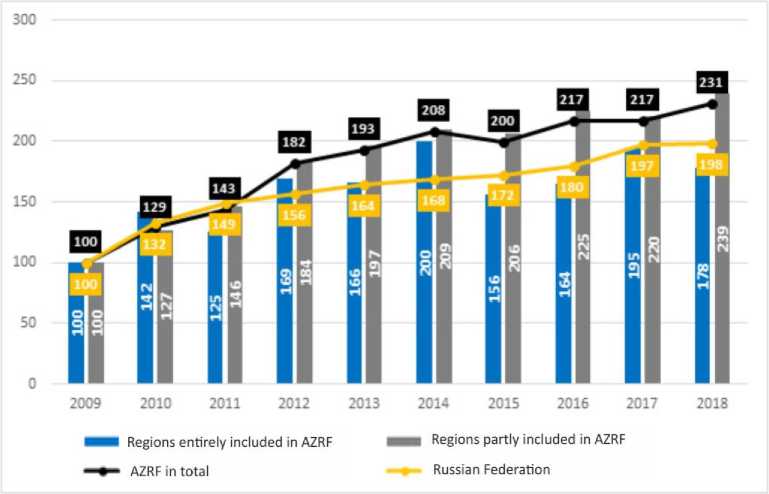
Fig. 4. The growth rate of travel agencies operating in the region (% compared to 2009).
According to this indicator, stable growth is observed at the national level and in regions partially included in the Russian Arctic. However, the growth rate of the number of travel agencies in Russia is much lower than the growth rates in partially arctic regions. As for the entire Russian Arctic regions, the peak value there was reached in 2014, followed by a significant decline, and as of 2018, this value has not been reached. In general, the growth rate for this indicator for the entire Arctic regions corresponds to the all-Russian level.
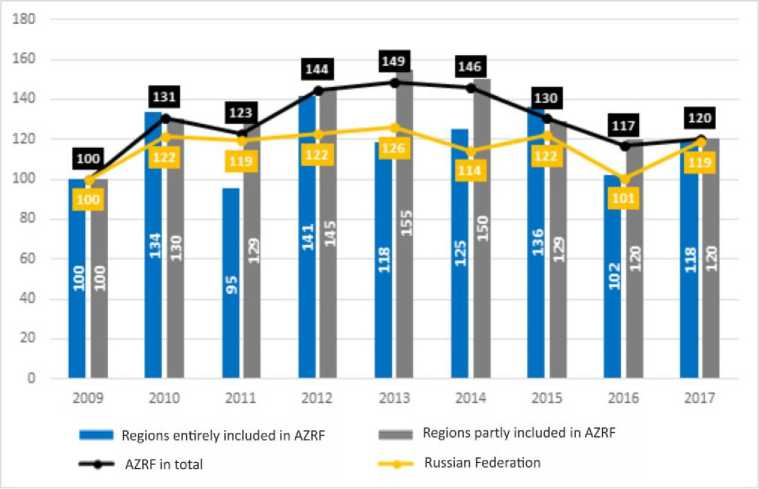
Fig. 5. The growth rate of people working in travel agencies (% compared to 2009).
The indicator reveals a stable growth in both at the national level and in regions partially included in the Russian Arctic, until 2013. Since 2014, a significant decline has been observed. It is worth noting that the growth rate of the number of people working in travel agencies in Russia is much lower than the growth rate in partially arctic regions. As for the regions that are entirely a part of the Russian Arctic, the peak value here was reached in 2012, after which there was a significant decline, and as of 2017, this value has not been reached. In general, the growth rates for this indicator of the entirely Arctic regions correspond to the all-Russian level. According to the activity of development of the indicator “development of tourism business”, the regions were divided into 3 groups (Table 3).
Table 3
Classification of regions according to the "development of tourism business" indicator
|
Lagging development (less than 0.80 points) |
Moderate development (from 0.80 to 1.00 points) |
Advanced development (more than 1.00 points) |
|
Development of tourism |
||
|
Nenets Autonomous Okrug (0,98) Murmansk Oblast (0,96) Arkhangelsk Oblast (0,95) Komi Republic (0,85) |
Republic of Karelia (1,32) Krasnoyarsk Krai (1,31) Yamal-Nenets Autonomous Okrug (1,19) Republic of Sakha (Yakutia) (1,06) Chukotka Autonomous Okrug (1,02) |
|
It is worth noting that not a single region fell into the group of lagging development for this indicator. Among the entirely Arctic regions, the Yamal-Nenets and Chukotka Autonomous Okrug were among the priority development groups. Among the partially arctic regions, the Arkhangelsk Oblast and the Komi Republic fell into the moderate development group. The remaining regions are in the group with advanced development.
The next indicator characterizing the active development of the tourism industry is the “profitability of the tourism and hospitality industry”. For a comprehensive assessment of this indicator, the following indicators were considered: the growth rate of the volume of services of collective accommodation facilities (Fig. 6) and the growth rate of the number of tourist services provided to the population (Fig. 7).
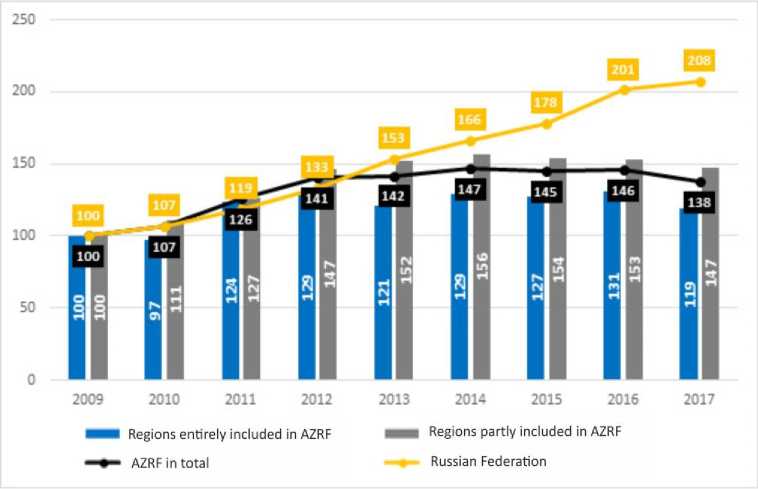
Fig. 6. The growth rate of collective accommodation facilities services (% compared to 2009).
According to this indicator, stable growth is observed only at the national level. As for the partially arctic regions, growth is observed only until 2014, after which this indicator stays at approximately the same level. It is also worth noting that, according to this indicator, entirely Arctic regions lag regions partially included in the Russian Arctic. In general, all-Russian growth rates significantly exceed the general Arctic level.
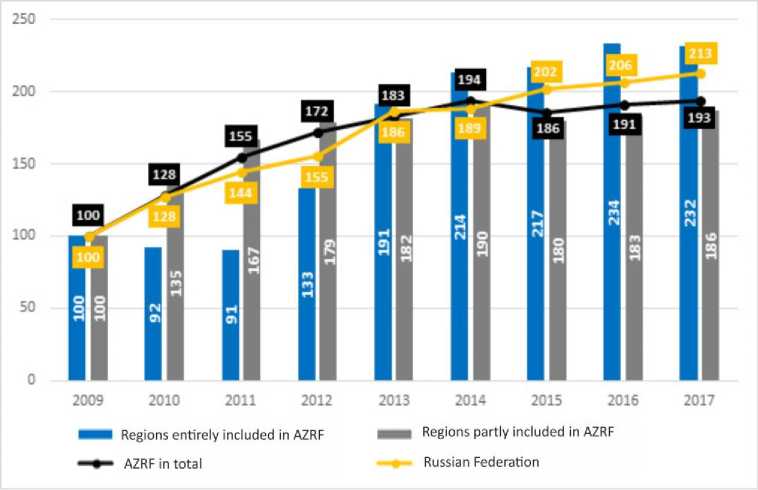
Fig. 7. The growth rate of tourist services provided to the population (% compared to 2009).
According to this indicator, stable growth is observed both at the all-Russian level and in regions of the Russian Arctic. It is worth noting that the growth rate of the volume of tourism services provided to the population of the entirely Arctic regions significantly exceeds the growth rate in the regions partially part of the Russian Arctic. According to the activity of developing the indicator “profitability of the tourism and hospitality industry”, the regions were divided into 3 groups (Table 4).
Table 4
Classification of regions by the “profitability of the tourism and hospitality industry" indicator
|
Lagging development (less than 0.80 points) |
Moderate development (from 0.80 to 1.00 points) |
Advanced development (more than 1.00 points) |
|
Profitability of the tourism and hospitality industry |
||
|
Murmansk Oblast (0,78) |
Arkhangelsk Oblast (0,88) Republic of Karelia (0,83) Komi Republic (0,83) |
Chukotka Autonomous Okrug (5,48) Yamal-Nenets Autonomous Okrug (1,24) Krasnoyarsk Krai (1,13) Republic of Sakha (Yakutia) (1,04) Nenets Autonomous Okrug (1,02) |
Among the regions that are entirely part of the Russian Arctic, only the Murmansk Oblast fell into the group of lagging development, while the rest of the regions are in the group with advanced development. Among the partially arctic regions, the Arkhangelsk Oblast, the Republic of Karelia, and the Komi Republic fell into the group with moderate development. At the same time, the remaining regions also fell into a group of regions with advanced development.
The next indicator of the active tourism industry development is the “popularity of regional tourism products”. Its comprehensive assessment requires the following indicators: the growth rate of the number of nights in collective accommodation facilities (Fig. 8), the growth rate of foreign citizens in collective accommodation facilities (Fig. 9), and the growth rate of Russian citizens in collective accommodation facilities (Fig. 10).
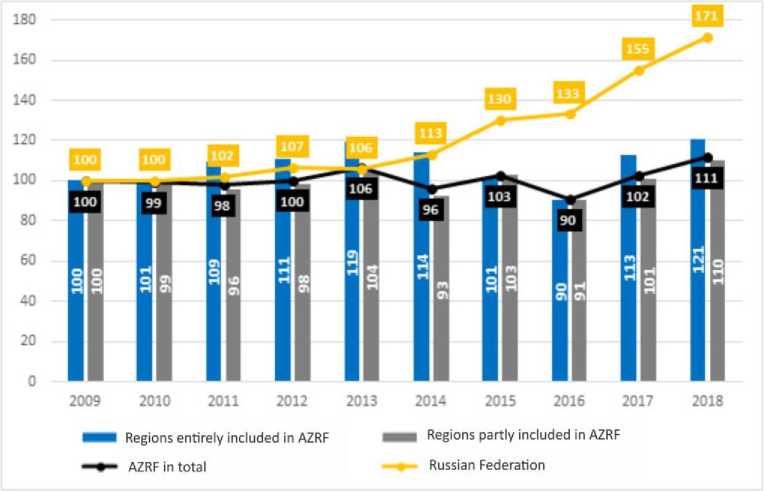
Fig. 8. The growth rate of the number of nights in collective accommodation facilities (% compared to 2009).
According to this indicator, stable growth is observed at the national level, but in the regions of the Russian Arctic, the growth is insignificant. The national growth rate for this indicator is higher than the overall arctic level. It is worth noting the indicators of entirely Arctic regions are slightly higher than the indicators of partially arctic regions.
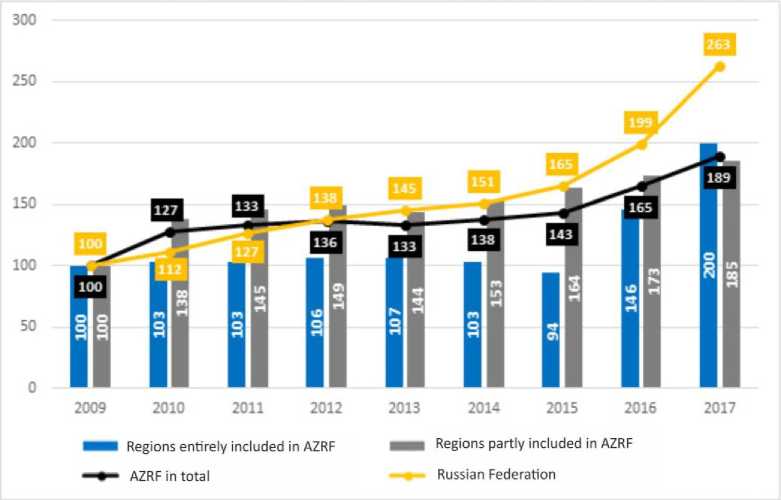
Fig. 9. The growth rate of foreign citizens in collective accommodation facilities (% compared to 2009).
According to this indicator, steady growth is observed both at the all-Russian level and in regions of the Russian Arctic. Still, the all-Russian growth rate of foreign citizens in collective accommodation facilities significantly exceeds the overall Arctic value. It is worth noting that the growth rate of tourism services provided to the population of partially arctic regions significantly exceeded the growth rates in the regions entirely included in the Russian Arctic until 2015, and only in 2016, the indicators reached relative parity.
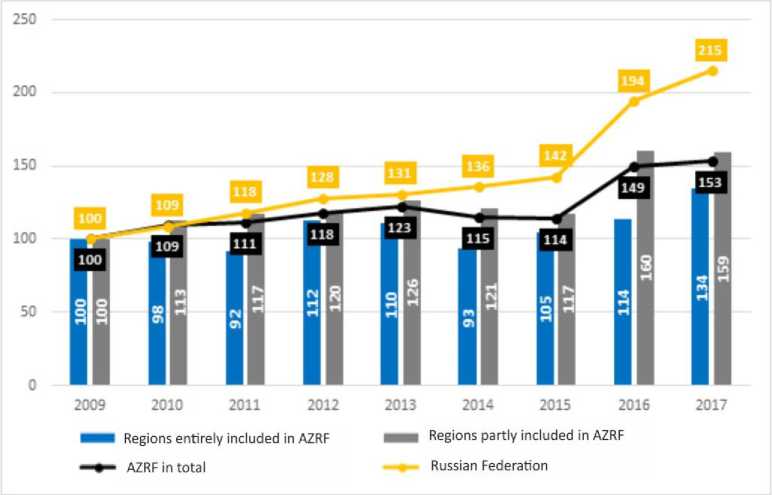
Fig. 10. The growth rate of the Russian Federation citizens in collective accommodation facilities (% compared to 2009).
According to this indicator, stable growth is observed at the all-Russian level. However, in 2014, in the Russian Arctic regions, a slight decline was observed. In 2016, a significant increase in indicators both at the level of the Russian Federation and the Arctic occurred. It is worth noting that the growth rate of tourism services provided to the population of partially Arctic regions exceeded the growth rate in the entirely arctic regions of Russia.
According to the development activity for the “popularity of regional tourism product” indicator, the regions were divided into 3 groups (Table 5).
Table 5
Classification of regions according to the “popularity of regional tourism products” indicator
|
Lagging development (less than 0.80 points) |
Moderate development (from 0.80 to 1.00 points) |
Advanced development (more than 1.00 points) |
|
Popularity of regional tourism products |
||
|
Murmansk Oblast (0.79) Komi Republic (0.78) Arkhangelsk Oblast (0.69) Nenets Autonomous Okrug (0.48) |
Krasnoyarsk Krai (0.95) Yamal-Nenets Autonomous Okrug (0.94) Chukotka Autonomous Okrug (0.83) Republic of Sakha (Yakutia) (0.82) |
Republic of Karelia (1,19) |
Among the regions that are entirely part of the Russian Arctic, the Murmansk Oblast, and the Nenets Autonomous Okrug fell into the group of lagging development. The remaining regions are in the moderate development group. Among partially arctic regions, the Arkhangelsk Oblast and the Komi Republic fell into the group of regions with lagging development. The Republic of Karelia is in a group with advanced development; other regions, partially arctic ones, are in the group of regions with moderate development.
Further, the scores of indicators of activity in the development of the tourism industry were summarized, and their arithmetic average was calculated. Following the assigned points, the regions were also divided in 3 groups (Table 6).
Table 6
Classification of regions according to indicators of activity in the tourism industry development
|
Lagging development (less than 0.80 points) |
Moderate development (from 0.80 to 1.00 points) |
Advanced development (more than 1.00 points) |
|
General indicator for the tourism industry development |
||
|
Republic of Sakha (Yakutia) (0.94) Murmansk Oblast (0.85) Arkhangelsk Oblast (0.84) Komi Republic (0.82) Nenets Autonomous Okrug (0.81) |
Chukotka Autonomous Okrug (2.07) Republic of Karelia (1.13) Krasnoyarsk Krai (1.07) Yamal-Nenets Autonomous Okrug (1.06) |
|
The Chukotka Autonomous Okrug, the Republic of Karelia, the Krasnoyarsk Krai and the Yamal-Nenets Autonomous Okrug were included in the group of regions with advanced development. The remaining regions of the Russian Arctic are in the moderate development group.
A comparison of indicators for tourism industry development activity (Fig. 11) showed no regions of the Russian Arctic in the lagging development group in terms of tourism industry development activity; the weaknesses are the low growth rates of the regional tourism product popularity and low growth rates profitability of the tourism industry, esp. among entirely arctic regions of Russia.
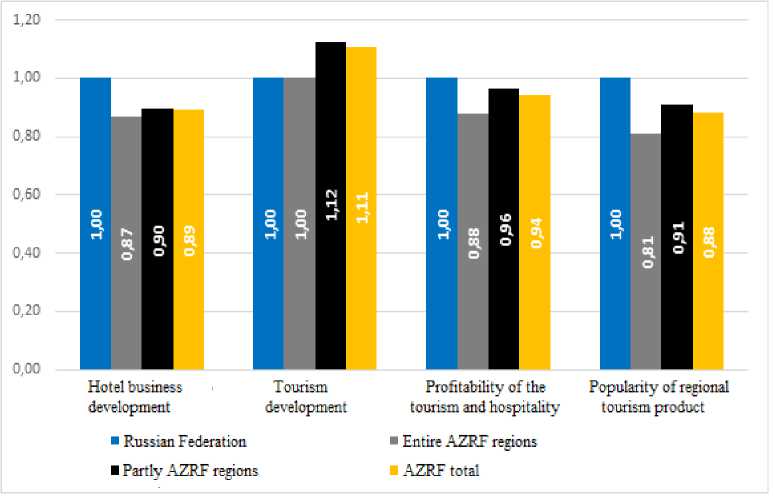
Fig. 11. Assessment of indicators of the tourism industry development activity.
Thus, testing the proposed methodology in the Russian Arctic revealed the weaknesses of the Arctic regions, i.e., the low popularity of the regional tourism product and the low growth rate of the tourism industry, esp. among the entirely arctic regions. The conclusions are consistent with the expert survey results of participants in the tourist and a recreational cluster of the Murmansk Oblast (Table 7).
An expert survey in the Arctic region — the Murmansk Oblast
The survey was attended by 15 experts, representatives of the tourist and recreational cluster of the Murmansk Oblast. It was an online survey with a predominance of open questions, distributed among participants through the cluster development center of the Murmansk Oblast.
Expert survey results
Table 7
|
Please rate the level of tourist potential of the Murmansk Oblast? |
|
|
Extremely high |
7 |
|
High |
6 |
|
Moderate |
1 |
|
Low |
1 |
|
Extremely low |
0 |
|
In your opinion, how effective is the state policy in the field of tourism in your region? |
|
|
Politics is effective |
0 |
|
Politics is more effective |
6 |
|
Politics is rather ineffective |
4 |
|
Policy is ineffective |
5 |
|
What do you think is hindering the development of tourism in the Murmansk Oblast? |
|
|
Lack of offers that could be of interest for potential tourists |
3 |
|
Poor awareness of tourism offers in the region |
8 |
|
Low qualification level of tourism sector employees |
3 |
|
The high cost of tourist services in the region |
7 |
|
Lack of interest on the part of investors and management structures in the tourism development in the region |
7 |
|
Low level of tourist infrastructure in the region |
8 |
|
Severe weather conditions |
2 |
|
Lack of support from the Ministry of Foreign Affairs on border issues |
1 |
|
Lack of interest of tourists in a regional tourist product |
1 |
Most experts (13 out of 15) rated the level of tourism potential of the region as high or very high; one expert rated it as average. Only one expert rated the level of tourism potential as low, motivating his answer with the lack of tourists' interest in the regional tourism product.
When asked about the effectiveness of regional tourism policy, most experts (9 out of 15) answered that the policy is ineffective/rather ineffective. One of the experts motivated his answer by the lack of support of the Ministry of Foreign Affairs in border territories issues.
As for the main factors hindering the development of tourism in the region, the most significant of them, according to experts, are: low awareness of the existing proposals in the field of tourism in the region; low level of tourist infrastructure in the region; high cost of tourist services in the region; lack of interest on the part of investors and management structures in the development of tourism in the region.
Conclusion
The result of testing the author’s methodology in the Arctic regions revealed the weaknesses of the Russian Arctic regions: the low popularity of regional tourism products and low growth rates of the tourism industry, esp. among entirely Arctic regions, which is consistent with the expert survey results. The main factors preventing the development of tourism in the region are poor awareness of the available offers in the tourism sector; low level of tourist infrastructure; high cost of tourist services, lack of interest on the part of investors and management structures in the development of tourism. We have proposed a set of measures aimed at reducing the influence of these factors and increase the development activity of the tourism industry [16, Yakovchuk A.A.]. Firstly, it is necessary to recognize tourism as a subsidized industry at the level of the region and its municipalities; secondly, it is necessary to secure provisions in the strategic and program documents of the region on the formation of a regional tourist brand, advertising and informational support for promoting a regional tourist product on domestic and foreign markets, and a campaign to promote a positive tourist image of the Murmansk Oblast in mass media.
Acknowledgements and funding
The article includes materials prepared under the state assignment of the FRC KSC RAS No. 0226-2019-0027.
Список литературы Tourism industry development issues in the Arctic zone of the Russian Federation
- Serova N.A., Serova V.A. Osnovnye tendentsii razvitiya transportnoy infrastruktury rossiyskoy Arktiki [Critical tendencies of the transport infrastructure development in the Russian Arctic]. Arktika i Sev-er [Arctic and North], 2019, no. 36, pp. 42–56. DOI: 10.17238/issn2221-2698.2019.36.42
- Skuf'ina T.P. Razvitie Severa i Arktiki: problemy i perspektivy [Development of the North and Arctics: problems and perspectives]. Uspekhi sovremennogo estestvoznaniya [Advances in current natural sciences], 2013, no. 4, pp. 133–138.
- Yakovchuk A.A. Sravnitel'nyy analiz praktiki primeneniya klasternogo podkhoda v Evrope I Ros-siyskoy Federatsii [A comparative analysis of cluster policy in the Russian Federation and the coun-tries of Europe]. Sotsial'no-ekonomicheskoe upravlenie: teoriya i praktika [Socio-economic man-agement: theory and practice], 2018, no. 4 (35), pp. 189–191.
- Johnston M. Polar tourism regulation strategies: Controlling visitors through codes of conduct and legislation. Polar Record, 1997, no. 33 (184), pp. 13–20.
- Johnston M. Evaluating the effectiveness of visitor-regulation strategies for polar tourism. Polar Record, 1998, no. 34 (188), pp. 25–30.
- Viken A., Jørgensen F. Tourism on Svalbard. Polar Record, 1998, no. 34 (189), pp. 123–128.
- Milne S., Ward S., Wenzel G. Linking tourism and art in Canada's eastern Arctic: the case of Cape Dorset. Polar Record, 1995, no. 31 (176), pp. 25–36.
- Baranov S.V., Bazhutova E.A., Biev A.A., Emel'yanova E.E., Serova V.A., Serova N.A., Skuf'ina T.P., Ya-kovchuk A.E. Osnovnye aspekty ekonomicheskogo razvitiya i upravleniya Arkticheskoy zonoy Ros-siyskoy Federatsii [The main aspects of economic development and management of the Arctic zone of the Russian Federation]. Moscow, Nauchnyy konsul'tant Publ., 2018, 214 p.
- Yuvanen E.I. Otsenka sotsial'no-ekonomicheskoy effektivnosti vnutrennego turizma v regione [Eval-uation of the socio-economic efficiency of domestic tourism in the region]. Vestnik Tikhookeanskogo gosudarstvennogo ekonomicheskogo universiteta, 2006, no. 3 (39), pp. 26–33.
- Murina S.G. Sistemnyy podkhod k otsenke effektivnosti regional'nogo turizma [A systematic ap-proach to assessing the effectiveness of regional tourism]. Vestnik Natsional'noy akademii turizma [Vestnik of National Tourism Academy], 2008, no. 1 (5), pp. 36–39.
- Rubtsova N.V. Soderzhanie ponyatiya effektivnost' turistskoy deyatel'nosti [Content of concept “ef-ficiency of tourist activity]. Regional'naya ekonomika: teoriya i praktika [Regional economics: theory and practice], 2012, no. 18 (249), pp. 54–60.
- Rubtsova N.V. Faktory effektivnosti funktsionirovaniya sfery turistsko-rekreatsionnykh uslug re-giona: teoreticheskie i prikladnye aspekty [Factors of the effectiveness of tourist and recreational services area of the region: theoretical and applied aspects]. Vestnik Zabaykal'skogo gosudarstven-nogo universiteta [Transbaikal State University Journal], 2018, vol. 24, no. 6, pp. 129–138.
- Meleshenko N.A. Otsenka effektivnosti deyatel'nosti regional'nykh organov vlasti v sfere turizma [Assessment of efficiency of activity of regional authorities in the sphere of tourism]. Politika, ekonomika i innovatsii [Politics, Economics and Innovations], 2018, no. 2 (19), p. 2.
- Kumar M., Prashar S., Jana R.K. Does international tourism spur international trade and output? Ev-idence from wavelet analysis. Tourism economics, 2019, vol. 25, no. 1, pp. 22–33.
- Javid E., Katircioglu S. The globalization indicators-tourism development nexus: a dynamic panel-data analysis. Asia pacific journal of tourism research, 2017, vol. 22, no. 11, pp. 1194–1205.
- Yakovchuk A.A. Otsenka effektivnosti regional'noy politiki v sfere turizma [Evaluation of the effec-tiveness of regional policy in tourism]. Ekonomicheskie otnosheniya [Journal of international eco-nomic affairs], 2019, vol. 9, no. 4, pp. 3103–3114. DOI: 10.18334/eo.9.4.41232

